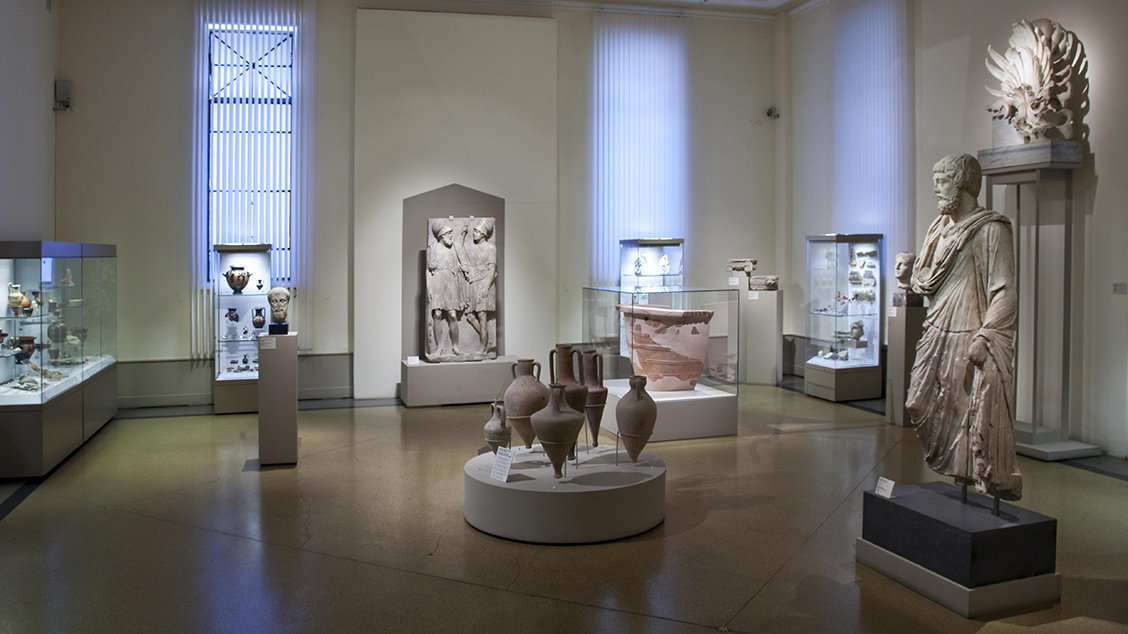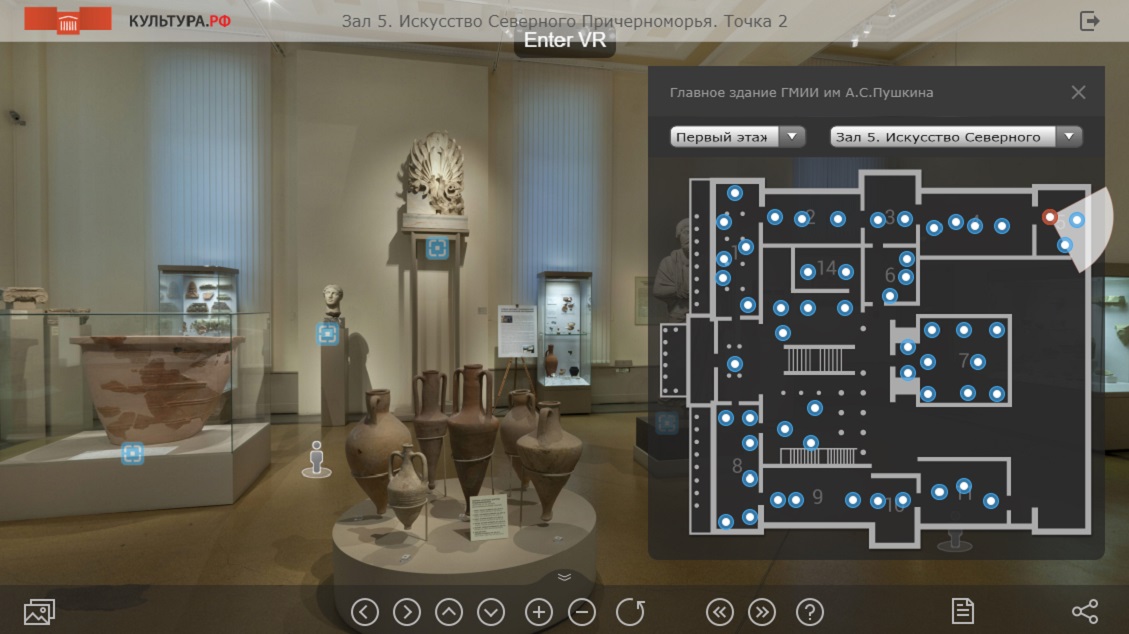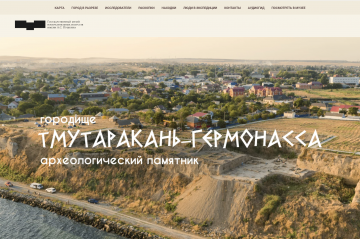The most ancient find relating to the time when the Milesian colony was founded at this site is a North-Ionian oinochoe decorated with a metope frieze with amphorae, dating from the 680s BC (Showcase No. 1). Buildings from that period have not as yet been discovered.
Construction Period I (650s-620s BC). The first archaeologically recorded buildings date from this period: they are 'dug-outs', round in plan and let into the natural soil. Finds from these primitive structures are displayed in Showcase No. 1: fragments of Ionian pottery and Attic black-figure vessels (No. 18) including fragments of lids from lekanides (jewellery caskets) with black-figure painting from the circle by Exekias (No. 19), a miniature mask of Silenus from the island of Samos (No. 17), fragments of stone moulds used for casting jewellery and arrows and an iron knife (Nos. 15 and 16). Fragments of hand-moulded vessels manufactured locally (Nos. 13 and 14) bear witness to early contacts between the Ionian settlers and the local Scythian population. The earliest of the written documents found on Mount Mithridates are unique: a dedicatory inscription from a certain Son to Artemis of Ephesus, carved on the bronze handle of an Etruscan vessel – an infundibulum and a graffito inscription scratched on the neck of a jug, from which it emerges that this prochus had belonged to an Ionian woman by the name of Mininda. (Showcase No. 1).
Construction Period II (590s-520s BC). During this period the architectural ensemble on the plateau to the West of the "Pervoye kreslo" (First Seat) of Mithridates was built, which included four multi-chamber structures arranged around the central building round in plan – the tolos. The excavations of this early public ensemble (an early pritaneion) have yielded up fragments of Attic black-figure vessels of various shapes in the painted decoration of which motifs of the Dionysian range predominate (Showcase No. 2). An extremely rare find was made in the building to the South of the tolos: fragments from a massive pottery bath for ablutions dating from the beginning of the 5th century BC. Baths have been found on more than one occasion during excavations at Classical sites, but the bath from Panticapaeum is truly unique, in so far as it is decorated with a narrative frieze depicting a chariot race in addition to the friezes of palmettes, lotus flowers and eggs. This is the only known example of a bath with decoration of this kind (Showcase No. 2). In the last quarter of the 6th century BC Panticapaeum, which had grown from a small Ionian settlement into a city – the capital of a polis - began to issue silver coins. (Examples of these Panticapaeum coin types are exhibited in Showcase No. 2).
Construction Period III. Phases I and 2 (590s and 580s BC). Levels evidencing fires and the collapse of the architectural ensemble with the tolos testify to the presence in those years of a military threat from the Scythian nomads. The population was obliged to take shelter once again in primitive 'dug-outs' erected on the ruins of former buildings. The first defensive installations at the Panticapaeum acropolis were erected at this time.
Construction Period IV (560s to the first half of the 4th century BC). This was a period with a more stable military and political situation as can be seen from the resumption of the construction of stone houses above ground. In a cellar room of one of the buildings a whole 'service' of Attic vessels was found: black-glaze bowls, kylikes, kantharoi with stamped decoration, a set of lamps, a miniature terracotta figure of the seated god, Bes, and a red-figure askos (Showcase No. 2).
Construction Period V. Phases 1-2 (third quarter of the 4th century to the mid-2nd century BC) – one of the most important periods in the history of the Panticapaeum acropolis, when the extensive architectural ensemble was built. It was a monumental two-storey building with a total area of 2,000 square metres. It had an inner courtyard surrounded by a two-tier colonnade – a peristyle. Round it were arranged subsidiary buildings and to the north there was the area containing a temple (or temenos). This ensemble probably served as the residence of the Spartocids – the basileia - referred to in Classical sources. This Gallery contains finds made in the course of the complex excavations of the basileia over many years: several architectural details - an Ionic capital from the second tier of the colonnade of the peristyle courtyard; a fragment from a cornice or sima with a spout in the form of a lion mask (on separate pedestals between Showcases 4 and 5). In Showcase No. 5 there are fragments of polychrome wall plaster and fragments of stone and pottery decoration, engraved plates of bone – details applied to furniture – and specimens of terracottas from the palace temple. Pottery stamps and a fragment from a stone matrix for manufacturing decorated gold plates for a female head-dress point to the fact that there would have a been a jewellery workshop in the palace. Lower down from these, fragments of dedicatory inscriptions from the palace have been displayed, also the head of a statue of Artemis and a fragment from a pedestal bearing a dedication of King Pharnaces, son of Mithridates VI, to the goddess Artemis Sumbomos from the shrine on the upper plateau of the acropolis.
A unique find was made during excavations of a 12-metre well in the main building of the basileia. Under a pile of architectural details the white marble head of a female deity was found (pedestal). This splendid original work of monumental sculpture was created in approximately the middle of the 4th century BC by a craftsmen who had been working in accordance with the traditions of the great Polykleitos. The statue and the palace itself suffered from the catastrophic earth-quake which had occurred in the second quarter of the 3rd century BC. Originally the head of the goddess had been crowned with a wreath or a diadem made of metal. After being repaired, this metal head-dress was replaced by a massive stone helmet and the sculpture became a depiction of the goddess Athena – the patron of the royal house of the Spartocids. Alterations to the statue could have been made in the course of restoration work in the mid-3rd century BC during the reign of Leukon II, on whose coins a depiction of Athena appeared for the first time. The date of the final destruction of the palace and the historic events with which it was linked can so far still only be guessed at and only new expeditions from our Museum can shed light on those.
Excavations at PHANAGORIA. Excavations of this centre in the Asiatic Bosporus, the largest of its kind, and of the necropolis were carried out between 1937 and 1957 under the leadership of M.M.Kobylina, I.D.Marchenko and A.K.Korovina. Among the most important finds made at that site are a marble acroterion which crowned a gravestone of Attic workmanship dating from the 4th century BC. The acroterion serves as the central exhibit in Gallery 5. Also on display here are gravestones, the depictions on which reflect the traditions and tastes of the inhabitants of the Asiatic Bosporus. A rare example of local sculpture is the head of a bearded man complete with a head-dress which was executed in the second half of the 4th century BC – possibly the portrait of a real individual (Showcase No. 7). Three marble slabs decorated in relief with a depiction of a nymphs' round dance, which must originally have framed an altar or a nymphaeum were worked between 200 and 150 BC in the so-called "archaistic" style. Numerous painted vessels have been found in the excavations of the necropolis at Phanagoria and most of them had been brought there from Greece: a fragment of a red-figure kylix with an Amazon on a horse (5th century BC), a red-figure krater with three male figures, pelikai with Amazons and griffins in the so-called 'Kerch' style (4th century BC), Hellenistic black-glaze vessels painted with slip and added white (Showcase No. 8). So-called Megarian bowls, richly decorated in relief, are among the finds manufactured in Asia Minor. Significant numbers of terracottas have also been yielded up by the excavations at Phanagoria and many of these had been made locally. The remains of workshops for manufacturing terracottas were also found, complete with intact finished output and the moulds used to make them. A work regarded as a true masterpiece of terracotta sculpture is the small head of a figurine of a satyr made in one of the workshops in Asia Minor. The polis of Phanagoria had its own mint and examples of some of its coins can be seen in this Gallery (Showcase No. 8).
To the South of Phanagoria, at the summit of the mud volcano known as "MAISKAYA GORA" (May Mountain), the Museum's archaeological expedition discovered the remains of an ancient shrine in which a crack in the rocks (or favissa) was full of discarded terracottas. More than a thousand fragments and complete specimens were found of protomes of Demeter, Aphrodite and Artemis during excavation work. Some of these terracottas are included in the Gallery's display (Showcase No. 8).
HERMONASSA – the second most important classical city on the Taman Peninsula. Painted pottery, represented in the display (Showcase No. 9), testifies to the active trade links which had existed between the towns of Hellas and Asia Minor from as early as the first half of the 6th century BC. Fragments of black- and red-figure vessels survived here, decorated by Greek vase-painters working in the 6th-4th centuries BC. A measuring vessel, with the impression of a stamp from the state magistrate and agoranomos on its wall, testifies to the high level at which commerce was organized in the city, demonstrating that the oinochoe in question served as an official standard of measurement. Among the objects of a religious character was a protome-censer, providing an example of how a classical Greek prototype might be reworked locally (Showcase No. 9).
The Pushkin Museum's expedition undertook excavations not only in large centres of the European and Asiatic Bosporus – Panticapaeum, Phanagoria and Hermonassa – but also in the necropoleis of such small Greek towns as TIRITACE founded in the second half of the 6th century BC to the South of Panticapaeum. In 1933-34 the excavations there were led by two members of the museum staff, V.D.Blavatskii and M.M.Kobylina. In the earthen tombs dating from the first centuries AD, clay and glass vessels were found (including vessels of Syrian manufacture), women's jewellery, and a large bead used as a seal dating from the 1st-2nd centuries AD made of rock crystal and bearing a carved depiction of a bunch of winged arrows (Showcase No.4). Plaster decorative details applied to sarcophagi were also found - in the shape of palmettes, dolphins, Medusa and actors' masks and the protome of a goddess in a dentate crown with traces of painted decoration (Showcase No. 4). The collection of the Pushkin Museum also contains materials from the excavations at SCYTHIAN NEAPOLIS – the capital of the Late Scythian kingdom in the Crimea, the ruins of which are on the outskirts of Simferopol (Showcase No. 10). In 1947-1948 P.N.Shults made a study there of a mausoleum of the Scythian nobility. One of the burials in the mausoleum was that of the great Scythian king, Scylures. His clothes were richly decorated with large numbers of gold plaques. The king's weapons were also found in the burial (swords, spears, arrows and a greave) and household articles – mirrors, jewellery, vessels. Ordinary inhabitants of the town were buried in earthen tombs. Imported vessels were found in Scythian Neapolis (red-glaze plates, a vessel with a depiction in relief of Eros and Hermes and glass articles) and also local pottery (a clay mug-cum-sieve for making cheese and a lamp decorated with white paste). The deceased had been buried with items of harness, parts of belt sets and numerous beads and gold plaques for decorating garments. Another item of interest is a cornelian scarab bearing a depiction of a bearded Scythian (Showcase No. 10). Many finds testify to the active trade links between the Scythian capital and the Classical centres in the North Pontic region and the Mediterranean.
Finds from the necropolis at TIRAMBA – a small Greek town situated to the East of Phanagoria – on the shore of the Sea of Azov originate from flat graves dating from the end of the 6th to the 3rd century BC. Excavations were carried out there between 1959 and 1965 by one of the Museum's expeditions led by A.K.Korovina. In some of the early warriors' burials weapons - swords, spearheads and arrows – were found. In the burial of a child, miniature arrow-heads were found, which had been made specially for a child's bow. Female burials dating from the 1st century BC to the 1st century AD contained jewellery in large quantities: fibula-fasteners, bracelets, beads, gold rings with carved garnet inlays. As well as imported and local pottery, numerous terracottas were discovered: figurines depicting the goddess of fate, Tyche, with a cornucopia, Aphrodite with Priapus and so on. One of the rare finds discovered in Tiramba was a glass vessel – a modius and an amphoriskos made from so-called Phoenician glass made in the Eastern Mediterranean region (Showcase No. 9). A limestone acroterion dating from the 3rd century BC was another of the finds from Tiramba (wall). It echoes the main decorative composition found on the earlier marble akroterion from Phanagoria but differs from it in that the details of the design are executed in a more schematic way.
In this Gallery two splendid works of art are displayed, which were discovered by the Museum's East Bosporan Expedition led by E.A.Savostina during excavations of an ancient property near the large village of Yubileinoye on the Fantalov Peninsula. One of them is a fragment of a limestone slab bearing a composition consisting of several figures: on it is depicted in high relief a battle scene between barbarians on foot and on horseback (an Amazonomachy?) (wall). This unique relief was fashioned by Bosporan craftsmen in the second half of the 4th century BC. The second work is a marble stele with two warriors (pedestal). This masterpiece created in the third quarter of the 4th century BC might well be interpreted as a monument to strategoi – representatives of the royal house of Spartocids.
The marble statue of Neocles, the ruler of Gorgippia, found in Anapa, which graces the centre of the Gallery, is a splendid example of monumental Bosporan sculpture from the Roman period.




